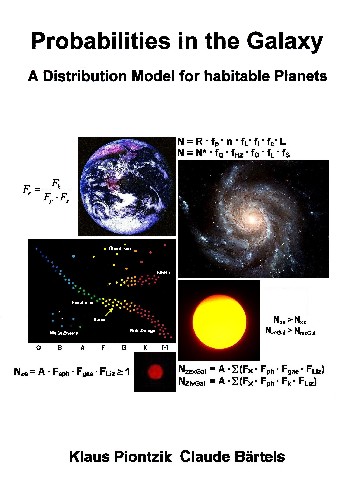In the previous
chapter it could be clarified, how many earth-like
planets exist, which could offer a basis for life. The
prerequisite for life is the presence of basic building
materials such as carbon, nitrogen, oxygen, sulphur,
phosphates and trace elements. And water, of course.
The
distance of the planet must be regulated in such a way
that gravity and size of the planet are dimensioned in
such a way that firstly a stable atmosphere can develop
and secondly that the triple point of the water is
stable. This is a fixed area between solid, liquid or
gaseous, which results from distance, gravity (mass of
the planets to each other), as well as centrifugal and
centripetal forces.
The
following options are available for a stable axis of
rotation:
These signals are
necessary for the development of living beings to
synchronize all structural, organic, nervous and mental
processes. Overall, therefore, an electromagnetic field
is required which has a certain temporal stability. As a
result, the Geodynamo must remain active for billions of
years. An example, if the Geodynamo comes to an early
standstill, is Mars. Once like earth with continents,
oceans and atmosphere, it became a dried out planet due
to the failure of the geodynamos and thus the magnetic
field.
5) Water (oceans, weather, climate)
6) Continents (plants, climate, weather)
7) Basic building materials (chemical elements)
8) Basic building blocks of life (amino acids)
|
|
The prerequisites for life described so far are
absolutely necessary. If a component is missing,
life is not possible. These factors represent
the hardware on which life is based.
|

|
DNA The building blocks of life, i.e. the amino acids, do not form DNA on their own.
There must therefore have been a factor or a process or an event that produced the ordered and replicable DNA strand from the individual, randomly distributed amino acids. These can be external influences such as specific environmental conditions or an introduction from outside (panspermia). The factor that created DNA can be called the "structural factor" fS. |

|
Cells Then another factor or process or event is
required that creates a complete cell from the DNA.
A cell also includes the shell and other structures such as chromosomes, RNA and additional amino acids and enzymes. Here, too, there can be external influences such as specific environmental conditions, as well as mutation and symbiosis or an introduction from outside (panspermia). The factor that produces living cells is therefore called "cell factor" fZ. |
| Where life arises, evolution occurs.
According to the convergence theory, the development of complexity
is a part of evolution. (see chapter 13.2)
Larger and more complex life forms are a prerequisite for the development of intelligence and consciousness. Since life forms are subject to evolution and its laws, their development is determined by a variety of influences. External influences are changes in environmental conditions. External influences can lead to changes in species directly or via epigenetics. Mutations represent another influencing factor. Since evolution is based on a certain randomness, the "evolution factor" fE can be introduced here, which stands for the probability of a constant and more complex evolution. All three factors together result in the "life factor" fL which causes all components to form a living cell with all its processes and complex life to develop from it. The life factor is then the software that is needed to get life going and keep it going. 4.1.1.1 Definition fL = fS · fZ · fE fL = life factor fS = structure factor fZ = cell factor fE = evolution factor By introducing the life factor, it can be taken into account that in addition to the emergence of life on Earth, the introduction from extraterrestrial sources, i.e. panspermia, is also possible. By introducing the life factor, it becomes irrelevant whether ife originated on Earth itself or was brought here through external influences. Overall, it follows that the hardware and software of life are necessary to enable life and its evolution on a planet. Therefore, the following axiom can now be stated: |
 |
4.1.1.2 Axiom If the planetary assumptions for life are given on a planet, then life also develops there. |
| There are 8
hardware requirements and 3
software components necessary for life. If all factors are independent
so 11 components work.
This results in FL
= 1:12.
This value is used as a basis in the following minimal considerations. |

|
176 sides, of them 64 in Color 76 pictures 11 tables Production and publishing: Books on Demand GmbH, Norderstedt ISBN 9-783-7528-5524-1 Price: 22 Euro |
|